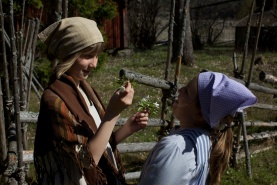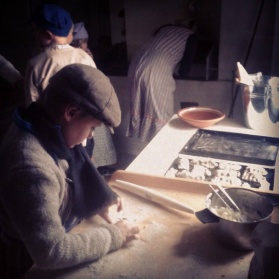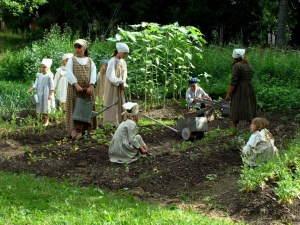Time travel in museums

Description
Museums use several methods to introduce visitors to history, and guided tours are one way of telling people about the past. However, there are often also children among the visitors on the guided tours who may not get much out of the tour. How to introduce children to history in an interesting, memorable and age-appropriate way? Time travel is a fun, pedagogical method based on reciprocity; it can be used to talk about past times and customs that form the basis of all modern culture. Time travel in museums is usually based on workshop activities and historical characters.
Typically, a journey through time with children follows a certain pattern: the journey begins by dressing up and ‘travelling into the past’. During the journey, the travellers complete various tasks and eat meals together. At the end, they return to the present day and their current roles. Time travel can be implemented in many different ways, but its core consists of the following: the journey through time is explained to the participants in advance and the visitors actively take part in the events, guided by people dressed up as historical characters and masters of old crafts.

Time travel may focus on doing things by hand, where the travellers learn about old crafts, or they can meet historical figures on the journey that tell them about the lives of their social group and their own lives during a certain period. The time travel can also involve a ritual (such as a wedding), an event (celebrating a name day) or an annual holiday (Midsummer). It can be tailored based on the group’s needs and wishes so that it focuses on a theme that is topical to the group. Period costumes, props and the museum facilities are used during the time travel, if possible, but in their absence you can simply rely on your imagination.
It is important that during a journey through time, each child completes the activities linked to time travel themselves by following directions and examples. Doing things with one's own hands and experiencing things comprehensively through all of your senses – how do the materials and the activity feel, what kind of smells are related to the topic – makes them memorable. Time travel communicates multifaceted information to children. It passes on know-how about old customs and habits, gives explanations for facts and beliefs, and teaches people about old practices, holiday customs, traditional foods and games. The local history of your own area comes alive and can be seen from a new perspective.
The Sagalund Museum is an open air museum and children’s cultural centre in Kemiö, established in 1900. It organises journeys through time for children based on local history, as is common for museums of cultural history in general. During the journeys through time, the children dress up in the clothing of a certain period and use the same tools that were used at the time. Our museum’s prop store contains costumes and tools from the 1700s to the 1980s. The contents of the prop store consist of authentic old tools that are not museum pieces, as well as copies of museum objects and costumes.

Background
Living history for pedagogical purposes started at Sagalund in the late 1980s. Characters were involved in the activities for the first time in the 1990s, and at that time, children were also included in the living history activities. Journeys through time directed at children started in the 1990s, and at the same time, old-style school days in the old primary school building were also started.
Handicraft activities required their own facilities: the experience workshop (Elämysverstas) was introduced in the beginning of the 2000s, and it is a space dedicated for museum pedagogical activities and crafts. The workshop is also used by the museum’s own club, Sagalundklubben; one of its operating principles is children teaching other children. The club members participate in public events, where they teach the skills they have learnt to other people. Since 2005, Sagalund has functioned as a museum pedagogic centre that shares information and ideas with other parties working with the cultural heritage and experiments with new ideas itself.
The journeys through time at Sagalund have been developed to suit our museums and the users of our services, such as schools. Among other things, we have learnt from the time travel method developed by Britt-Marie Borgström from the Jamtli open air museum, Henrik Summanen from the Interactive Institute in Stockholm as well as Charlotte Hultén from the Museum of Mölndal.
Future
In the implementation, we cooperate with local and regional parties, such as the local department of cultural services, other local museums and the local music school. Co-operation also occurs with partners at national level. These include the network of Finnish children’s cultural centres.
The Sagalund children’s cultural centre follows ecological principles in its operation, and ecology is also connected to the time travel. This is especially evident in our school vegetable garden activities, where the children cultivate the garden and grow greens and root vegetables as organically as possible. The vegetable garden activities are also a journey to a time of self-sufficiency. Vegetable gardens have been established in the museum garden, the yards of schools in Kemiönsaari and the neighbouring municipalities, as well as in connection with 4H clubs; there, the children can experience the joy of growing things from seed to harvest. In the future, the themes of ecology and sustainable development will be emphasised even more in children’s activities.
The community/communities behind the submission
Bibliography and links to external sources of information
Children’s cultural centers in Finland
Björkman, John & Näse, Li, 2009. Sagalund lever. Inspiration till livslångt lärande.
Kamara, Anna & Tiainen, Kristiina, 2015.Kädet multaan! Koulukasvimaa alakouluikäisille. Lastenkulttuurikeskuksen menetelmäopas.
Ylikoski, Annina 2012 Att resa över tid och rum. Metodguide om tidsresor och kulturarvspedagogik. Metodhandbok för barnkulturcentrum.
Slotte, Johanna, 2013. Barnen på råttfällan.
Slotte, Johanna 2015. Barnen på krängbänken.
